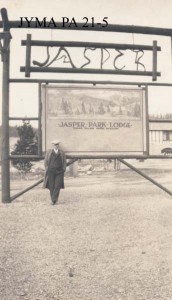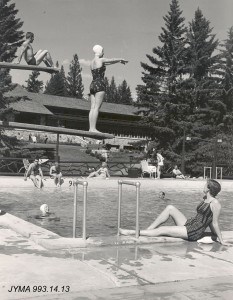
Over the past century, the Fairmont Jasper Park Lodge has evolved from a tent city to the sprawling world-class hotel and golf course that has become a quintessential part of the Jasper experience.
With the expansion of the Grand Trunk Pacific Railway from Edmonton to Jasper in 1911, the railway company quickly set its sights on creating a tourist camp to host travellers as they made their way through Jasper National Park, which had been established only four years earlier.
Recognizing the potential of the area, the company sent an employee, Mr. H. R. Tilley, to Jasper in 1915 to investigate potential locations for a temporary tourist camp, according to Jasper Park Lodge, a book by Cyndi Smith.
Accompanied by Fred and Jack Brewster, the trio checked out a number of viable locations, including Lake Edith and Pyramid Lake, before the Brewster brothers showed Tilley their favourite location, along the shore of the turquoise waters of Lac Beauvert, which at that time was called Horseshoe Lake.
Almost immediately Tilley selected Lac Beauvert as the future spot of the tourist camp because of its distinct vantage point, which includes a clear view of Whistlers Mountain, Signal Mountain, Pyramid Mountain, Roche Bonhomme (Old Man) and Mt. Edith Cavell.
In addition, the Athabasca River was only a stone’s through away, and there was already a log suspension bridge across it near Old Fort Point. A road also connected Lac Beauvert to Maligne Canyon, making it an easy trip to the popular tourist destination.
“The thing I like most about the history of Jasper Park Lodge is that it was opened as a wilderness resort,” said Ken Hall, the hotel’s general manger.
“The Brewster brothers met with the train executives and came here and stood on the shores of Lac Beauvert and said, ‘this is where we need to have a wilderness retreat for people.’”
Within a few short months, 10 large tents, each with a wooden floor and walls, were constructed and on June 15, 1915 Jasper Park Camp, commonly referred to as “tent city” was officially opened.
Robert Kenneth, the man who spearheaded the construction, managed the camp and immediately hired a chef, waitresses and housekeepers.
On opening day, rates at the camp were $2.50 and $3 per day or $15 and $18 per week. The Brewster brothers charged $1 for a round trip from the railway station to the camp with horsedrawn carriages. The Grand Trunk Pacific Railway also offered a special round-trip ticket from Edmonton to Jasper that was valid for two weeks for $8.45.

That same year, with tourism booming, Jack and Fred Brewster bought the camp from Kenneth and immediately built a log kitchen and dining room.
According to S. Maynard Rogers, the park superintendent at the time, there weren’t enough rooms for the number of guests visiting Jasper.
“The park was crowded beyond capacity of accommodation all through the past season, and the want of a suitable and modern hotel is a serious handicap. The ‘Tent City’, with accommodation for 60 guests, was compelled to put out the ‘no accommodation’ sign nearly every train day,” stated Rogers in an annual report in 1919.
With both the Grand Trunk Pacific Railway and the Canadian Northern Railway struggling to stay afloat, the Canadian National Railway Company was formed to absorb both companies.
By 1921, CN rail bought the camp from the Brewster brothers and immediately upgraded the tents to eight temporary log bungalows and officially opened “Jasper Park Lodge” in June 1922.
With a capacity of 65 guests, each new bungalow had four bedrooms and a lounge. There was also a main dining hall and central lounge that could host even more people, as the lodge encouraged people to pitch tents on the site of the old camp.
As word spread about Jasper, further plans were created to expand the hotel. Over the winter of 1922 and 1923 construction of a central building was well underway.
After it was completed, it was touted as the largest single-storey log structure in the world and included lounges, a dining room, snack room, kitchen, card rooms, shops, a hairdresser, manicure salons and administrative offices.
In addition to the new building, on July 17, 1925 the Jasper Park Lodge Golf Course was officially opened after being designed by Canada’s master golf architect Stanley Thompson.
The par 71 course is the only golf course in the park and is today considered the No. 1 resort golf course in Canada.
“It’s important to the destination and it’s really a prized possession,” said Hall, who added the golf course recently celebrated its 90th anniversary.
In 1927–28 the lodge was enlarged again, with the rotunda doubled in size. Every evening, except for Sunday, an orchestra played in the ballroom where at least 300 people could comfortably dance and tea was served in the afternoon on the veranda of the lodge—a tradition that continues to this day.
Each bungalow ranged in size from four rooms to 20 rooms, and by 1927 the hotel could host 425 guests a night and had its own fleet of cars to pick guests up from the railway station.
In 1926, an outdoor swimming pool was constructed and several other amenity buildings were added over subsequent years, including the golf clubhouse. In 1930, more cabins were built increasing the hotel’s occupancy to 550 people.
With the Second World War already into its third year, the lodge was closed from the fall of 1942 to the spring of 1946.
At the time, management of the CN hotel department said the decision was made “as a result of a careful study of Canada’s wartime economy, including manpower, foodstuff and transportation.”
During the war, the lodge was temporarily used as a base for the Lovat Scouts, a Scottish regiment being trained as special mountain troops.

Throughout its 100-year history, the lodge has had its share of destructive fires.
The first major fire broke out on July 15, 1952 at the height of the tourist season, completely gutting the main lodge.
With 580 guests, the community rallied, quickly extinguishing the fire and opening its doors to displaced guests.
The majority of guests were able to return to their bungalows after the fire was brought under control, while those who were staying in the lodge itself were housed by people in town or spent the night in a sleeping car at the train station.
Construction of a new lodge began almost immediately after the fire, and by September workers had already begun pouring concrete for a new foundation.
By November of 1952, the first structural steel was installed and the roof was completed by winter. Through the winter, more than 400 men continued to work on the lodge and by June 9, 1953, less than a year after it burnt down, the lodge was reopened.
The cost of the new building was roughly $3 million and is still used today as the main lodge, albeit with renovations and additions such as the Emerald Lounge.
Between the early 1940s and 50s, most of the original log cabins were replaced with modern cedar cabins and by the 1960s and early 70s the hotel added an outdoor heated pool, tennis courts, golf clubhouse and the Beauvert Suites located on the shores of Lac Beauvert.
In 1988, the Jasper Park Lodge was bought by Canadian Pacific Hotels and Resorts and became a four-season resort.
In 2000, the lodge suffered another serious fire, which burnt down the Outlook Cabin, also known as the “royal retreat,” which hosted King George VI and Queen Elizabeth in 1939.
Due to the cabin’s historic significance, the Fairmont rebuilt the cabin as close to its original layout as possible, including replicas of the original furniture and paintings.
In 2005, Queen Elizabeth II and Prince Phillip stayed in the rebuilt cabin during their visit to Alberta to celebrate the provinces 100th anniversary.
In 2011, another fire destroyed the Stanley Thompson Cabin built in 1972 and in 2012, a fire broke out in the main lodge, burning part of its roof.

Over the years, the lodge has attracted a diverse group of guests from around the world and was even chosen as the location for several Hollywood films, such as River of No Return starring Marilyn Monroe and Robert Mitchum.
When celebrities come to town, they often select the lodge as the place to lay their heads during their stay.
“They really enjoy privacy and the nice thing about Jasper is it provides space for them to get away and relax,” said Hall.
In 2006, the hotel changed hands again after being purchased by the Ontario Municipal Employees Retirement System (OMERS), which also owns seven Canadian Fairmont hotels, including the Banff Springs and Chateau Lake Louise.
Today, the lodge has 86 different cabins with 446 rooms and can accommodate up to 1,500 people a night, said Hall.
On average the hotel has an occupancy rate between 60 to 70 per cent with occupancy soaring to 90 per cent in July and August.
In addition to the hotel rooms, the resort also has 26,000 square feet of meeting space and hosts more than 100 weddings each year.
Currently, the hotel is investing more than $16 million to improve rooms, public spaces and infrastructure with 90 per cent of the renovations to be completed by May 1, 2016.
Perhaps what is most interesting about the lodge, however, is the fact that about 600 employees live, eat and sleep at the lodge, making it its own community just outside of town.
For Jennifer Melanson, director of human resources and a Fairmont employee for the past 22 years, she spent three summers as a young person working for the hotel, before she decided to make a career out of it.
“I enjoy the camaraderie, I enjoy the sense of family that’s here and I felt that at every stage of my career,” she said.
“I always say to employees when they come [to work here] that the best thing about this place is you live where you work and the worst thing is you live where you work, because that comes along with some challenges,” she said with a chuckle.
“You don’t just see people for eight hours a day in a work environment, you’re socializing with them, you’re going on outdoor adventures with them, you are living next to them, so you really see people for what they are.”
Paul Clarke
[email protected]
